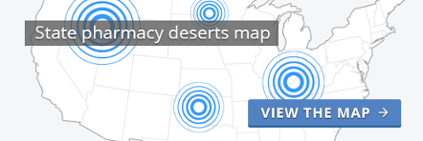In cities and metropolitan areas, we take pharmacy access for granted. We have easy access to hospitals, health systems and emergency care services, minute clinics and our choice of independent pharmacies or chains, some of which are located across the street from each other.
But there’s a problem we’re unaware of because most of us don’t physically experience it.
Millions and millions of patients struggle to access pharmacy services every single day. 60 million people, or 19.3% of the population of America, do not live in big cities and urban areas. One out of every five (1 of 5) people in the United States choose to live in small communities, and it is their right to stay there. They currently travel out of town to fulfill their pharmacy needs, but factors such as adverse weather and simple inconvenience can impede upon receiving adequate care and staying adherent to their medications, let alone filling them in the first place.
Sizing up the pharmacy access problem
There are 7,000+ cities in America without a local pharmacy and 5,100+ cities without any sort of healthcare services at all, according to our research. There are 1,500+
 in America, or towns located ten (10) or more miles driving distance from the nearest retail pharmacy. Independent and rural-based pharmacies have been closing at an alarming rate, and 3,900+ cities are at-risk of losing their only pharmacy.
in America, or towns located ten (10) or more miles driving distance from the nearest retail pharmacy. Independent and rural-based pharmacies have been closing at an alarming rate, and 3,900+ cities are at-risk of losing their only pharmacy.
For the most part, patients living in rural or underserved communities struggle to access standard medication like antibiotics or insulin. They don’t have local access to a pharmacist so they wrestle with medication adherence, sometimes driving 20+ minutes to fill their prescriptions, or sometimes not. They don’t have local access to pharmacist provided services like comprehensive medication reviews (CMRs), medication synchronization, diabetes counseling and more.
As a pharmacist or pharmacy owner, what are you doing to offer convenient access to your services? How are you connecting with underserved patients so they can benefit from the care, expertise and medication you provide?
Telepharmacy: A solution for the underserved patients of America
Medically underserved patients need your help, and telepharmacy is a tool that helps pharmacists and healthcare organizations improve access to care. Take Atwood, Illinois, for example. Atwood is a small rural community of about 1,200 people located in west-central Illinois. The community didn’t have a local pharmacy for years until Dave Falk and Sav Mor Pharmacy came to town.
“We’re focusing on telepharmacy to bring pharmaceutical services back to rural communities like Atwood, and the people here love it,” Dave said. “They are pleased that we’ve brought a pharmacy to their town. Here in Atwood it’s been well over 15 years since a pharmacy existed. A generation, if you will, have had to travel well over 10 miles each way to get a prescription filled.”
Dave opened his first telepharmacy in 2016 and has since opened three more serving five total communities in Illinois. Illinois has telepharmacy regulations that favor patient access, but after opening the remote-dispensing site and talking with patients, Dave now understands how tough it can be to acquire medication.
“Whether it’s inclement weather or you’re just having a bad day, traveling 30+ miles roundtrip to a pharmacy is a long distance for some patients, he added. ”The telepharmacy model is feasible in smaller communities, allowing us to provide critical pharmacy access to patients living in rural areas.”
Barriers beyond rural communities
But pharmacy access isn’t just about distance. There are many other factors that influence how community members are able to get to pharmacies and fill their prescriptions. Just as rural
 are a concern, urban pharmacy deserts have become a problem as well. “Of Chicago’s 802 census tracts, 32 percent were in pharmacy deserts,” according to a study performed by The University of Illinois-Chicago (UIC). “Approximately one million people live in pharmacy deserts (in Chicago), and 53 percent of these people live in segregated black communities.” The authors of the study continued. “Our findings suggest that public policies aimed at improving access to prescription medications may need to address factors beyond insurance coverage and medication affordability.”
are a concern, urban pharmacy deserts have become a problem as well. “Of Chicago’s 802 census tracts, 32 percent were in pharmacy deserts,” according to a study performed by The University of Illinois-Chicago (UIC). “Approximately one million people live in pharmacy deserts (in Chicago), and 53 percent of these people live in segregated black communities.” The authors of the study continued. “Our findings suggest that public policies aimed at improving access to prescription medications may need to address factors beyond insurance coverage and medication affordability.”
The authors of the study urged policy leaders to recognize the importance of pharmacy access and the pharmacy desert problem, especially for its impact on population health. Through conveniently located pharmacies (or telepharmacies), pharmacists are able to provide important access to prescription medication and preventative services that can help keep patients out of hospitals and clinics.
What’s best for the patient?
At the end of the day, we must ask ourselves: "What’s best for the patient?" As pharmacists, pharmacy owners and state board of pharmacy members consider new technology to better serve patients, it's imperative that we do our part to reach the underserved and improve care. Technology has come a long way, even in the last five years. What seemed like a dream long ago [telepharmacy] has since become a reality — and it works, with a lower dispensing error rate than traditional pharmacy.
"This is a local company. My dad started a pharmacy in North Pole in 1987, so I've been in pharmacy my whole life. Telepharmacy was one of his dreams, but the technology just didn't exist."
- Leif Holm, pharmacist and owner of Alaska’s first community telepharmacy.




